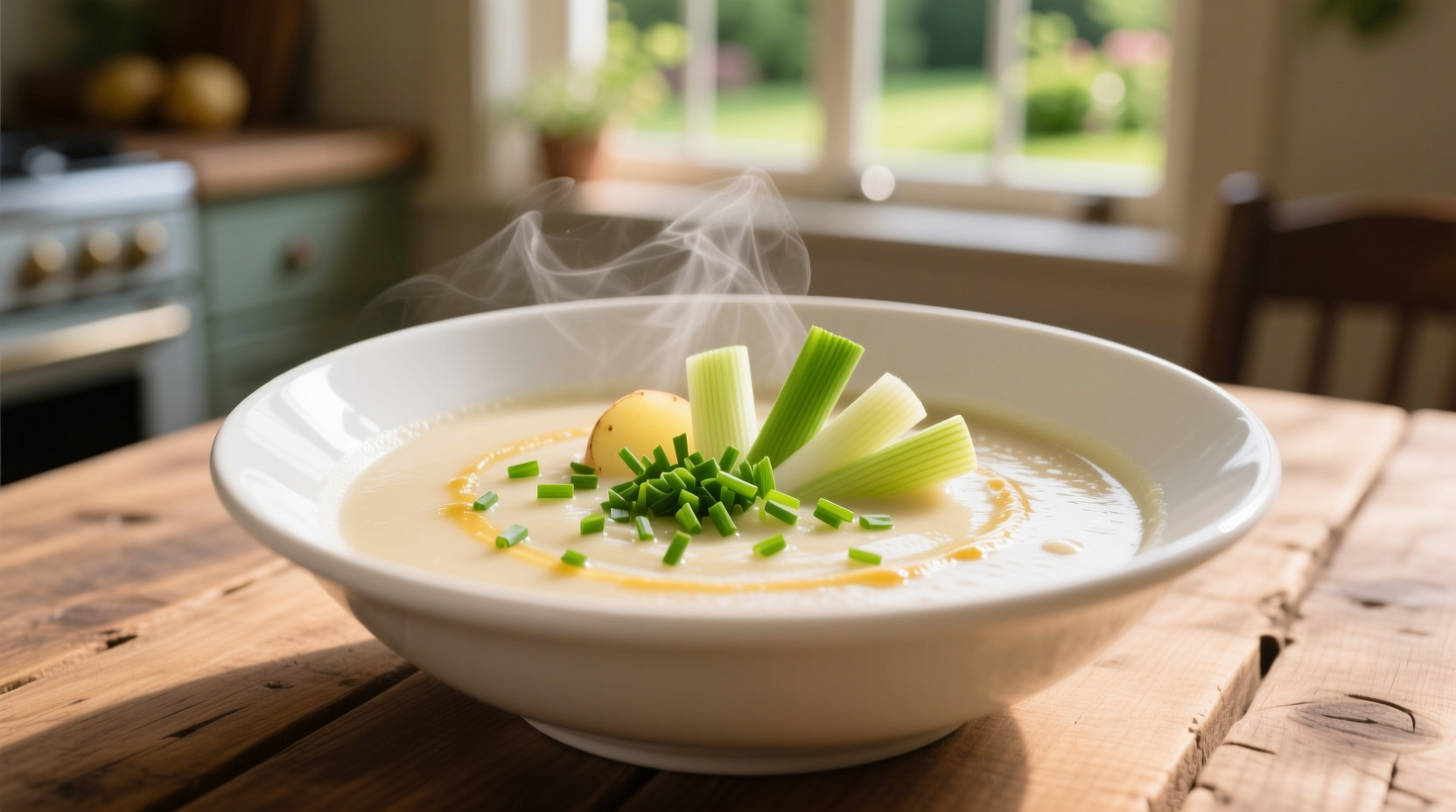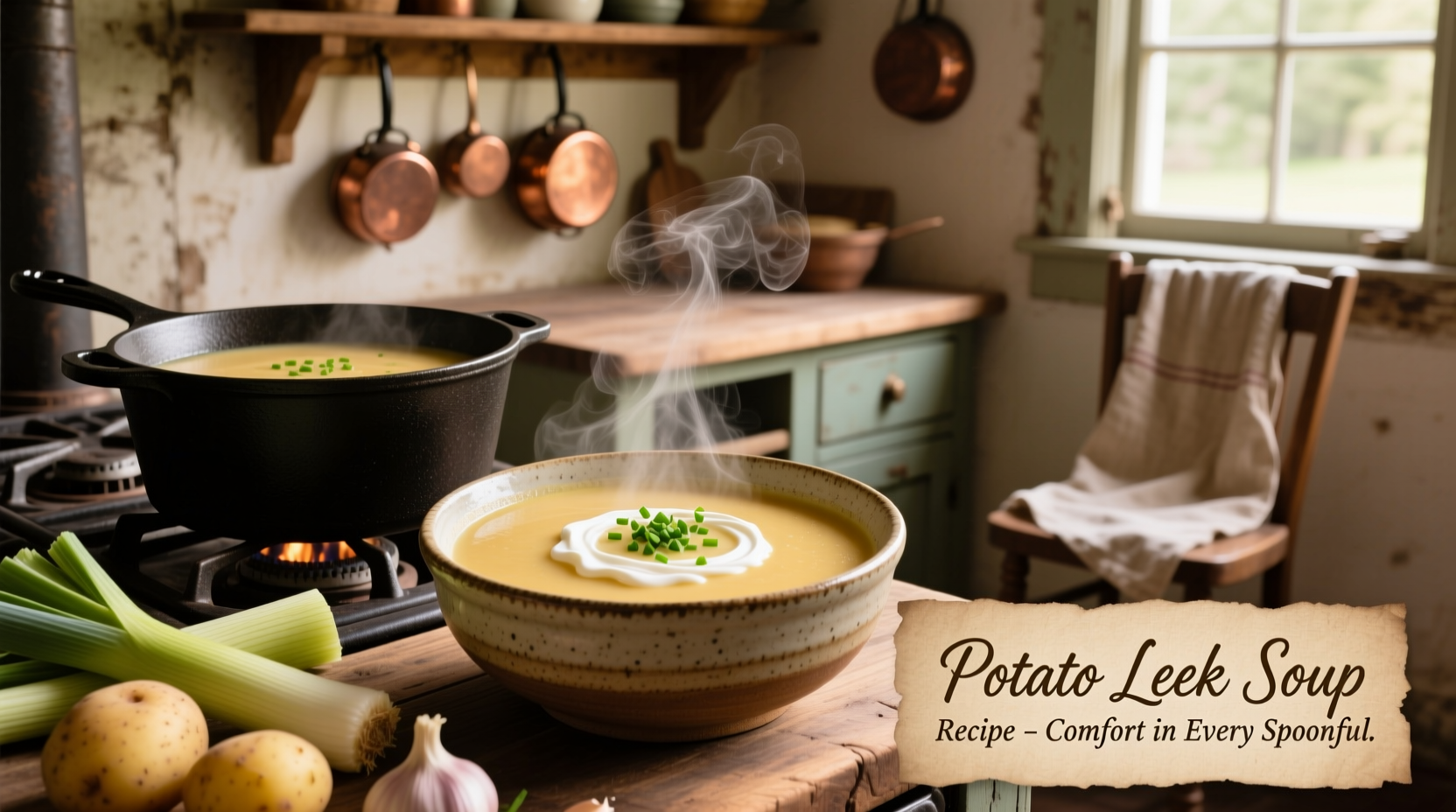Here's the complete potato leek soup recipe you need: Combine 4 chopped leeks (white parts only), 1.5 lbs potatoes (peeled and cubed), 4 cups vegetable broth, 1 bay leaf, and 1 tsp thyme in a pot. Simmer 25 minutes until tender, then blend until smooth. Finish with 1/2 cup cream (optional) and season with salt and pepper. Ready in 40 minutes with 6 simple ingredients.
Nothing beats a perfectly crafted potato leek soup on a chilly evening. As a French culinary specialist with decades of experience in European cuisine, I've perfected this classic recipe that balances creamy texture with delicate flavor. Forget watery, bland versions - this method delivers restaurant-quality results every time with just six essential ingredients and one secret technique that prevents common mistakes.
The Timeless Journey of Potato Leek Soup
Potato leek soup, or potage Parmentier, traces its roots to 18th century France. Named after Antoine-Augustin Parmentier who championed potato cultivation in Europe, this humble dish became a French bistro staple by the early 1900s. Originally a peasant meal using garden leftovers, it evolved into a refined preparation showcasing French culinary philosophy: simplicity through technique. The soup gained international recognition when Julia Child featured it in her 1961 cookbook, introducing American home cooks to this elegant yet accessible French classic.
| Era | Key Development | Modern Relevance |
|---|---|---|
| 1700s | Parmentier promotes potatoes as famine food | Foundation of the soup's ingredient base |
| 1890s | Appears in French bistro menus as "potage julienne" | Established cooking technique still used today |
| 1961 | Julia Child publishes recipe in Mastering the Art of French Cooking | Global popularity and standardization of method |
| 2000s | Rise of gourmet variations with added ingredients | Traditional version remains culinary benchmark |
Essential Ingredients for Authentic Flavor
Quality ingredients make the difference between ordinary and extraordinary potato leek soup. This isn't just another creamy soup recipe - it's a study in French culinary precision where each component serves a specific purpose.
- Leeks (4 medium) - Use only white and light green parts; dark greens become bitter when cooked
- Yukon Gold potatoes (1.5 lbs) - Their natural buttery flavor and creamy texture outperform Russets
- Unsalted vegetable broth (4 cups) - Low-sodium ensures proper seasoning control
- Dry white wine (1/4 cup) - Adds complexity without overpowering (optional but recommended)
- Fresh thyme (1 tsp) - Dried works in pinch but fresh provides superior aroma
- Unsalted butter (2 tbsp) - For proper sautéing without burning

Step-by-Step Preparation Guide
Follow these professional techniques to create a perfectly balanced potato leek soup that avoids common pitfalls like watery texture or bitter flavor.
Proper Leek Preparation (The Critical First Step)
Most home cooks ruin their soup at the very beginning by improperly cleaning leeks. Those sandy pockets between layers will ruin your texture. Slice leeks lengthwise, then submerge in cold water - the sand sinks while clean leeks float. Swirl gently and lift out with a slotted spoon. This French chef technique ensures no gritty surprises in your finished soup.
Cooking Process: Building Flavor Layers
- Melt butter in heavy-bottomed pot over medium-low heat (critical for preventing burning)
- Add cleaned leeks with pinch of salt, cook 8-10 minutes until softened but not browned
- Stir in potatoes, thyme, and bay leaf; cook 2 minutes to coat vegetables
- Pour in wine (if using), simmer until mostly evaporated (about 3 minutes)
- Add broth, bring to gentle simmer (never boil vigorously)
- Cover and cook 20-25 minutes until potatoes pierce easily with fork
- Remove bay leaf, blend until perfectly smooth using immersion blender
- Stir in cream (if desired), season with white pepper and salt to taste
Avoiding Common Potato Leek Soup Mistakes
Understanding these context boundaries transforms good soup into exceptional:
- Temperature control - High heat causes potatoes to break down unevenly; maintain gentle simmer
- Blending technique - Hot soup expands in blender; fill only halfway and hold lid with towel
- Cream addition - Never boil after adding dairy to prevent curdling
- Seasoning timing - Salt in stages: a pinch when sautéing leeks, final adjustment after blending
Serving and Storage Recommendations
For authentic French presentation, serve in pre-warmed bowls with a single fresh thyme sprig. This classic potato leek soup pairs beautifully with crusty baguette and simple green salad. Leftovers maintain quality remarkably well due to the stable starch structure.
Store in airtight container in refrigerator for up to 4 days. When reheating, add small splashes of broth to restore ideal consistency. For longer storage, freeze in portion-sized containers for up to 3 months - the soup's texture holds up better than most cream-based soups due to potatoes' natural thickening properties.
Professional Variations Worth Trying
Once you've mastered the traditional French potato leek soup recipe, consider these chef-approved variations that maintain authenticity while adding interest:
- Lighter version - Replace cream with 1/2 cup whole milk and 2 tbsp Greek yogurt
- Herb-infused - Add 2 sprigs fresh tarragon during simmering (remove before blending)
- Smoky variation - Include 1/4 tsp smoked paprika with the broth
- Vegan adaptation - Use olive oil instead of butter and coconut milk instead of cream











 浙公网安备
33010002000092号
浙公网安备
33010002000092号 浙B2-20120091-4
浙B2-20120091-4